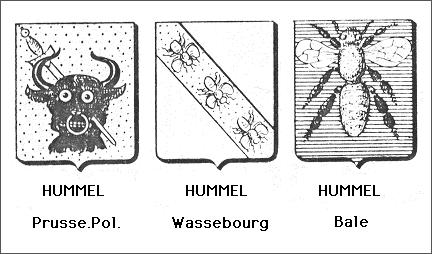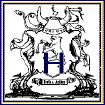Coat-of-Arms and Family Heraldry continued
In translation, the German word "hummel" when translated refers to a "bumblebee". The bee is quite a popular symbol and was used by Childeric, the father of the Frankish King Clovis, and later by Napoleon after he crowned himself Emperor of France.
The surname Hummel is of German origin and that the name's old root word is Humbal from Old German meaning bumblebee, which was a nickname given to a man who had an "excitable" temperament or a man who was very industrious. The coat-of-arms mentioned is the one shown in the middle below: "Shield: Silver background, three silver bees, heads down, on a diagonal gold stripe.".
The German word for bee, however, is not "bal", the word is "Beine.
Hummel Coat-of-Arms

Coat of Arms: Bulls head [erased; with neck showing] with a ring in the nose, gritting teeth and a sword through it's head. A bull is one of the rare examples of beasts that can never be represented "proper" accept when used as a supporter on in badges. In this shield it may display some kind of victory over a family who's crest held the head of a bull.
Hummel of Wassebourg.
Wassebourg....
Coat of Arms: The [gold] bend has three [silver] bees with heads pointed toward the lower corner.... The background is silver. The bee is "volant en arriere".
Hummel of Bale.
Bale is French for Basel, a canton in N. Switzerland which borders on the French and German border. In English it is spelled Basle....
Coat of Arms: A single bumblebee volant with it's head upward.

